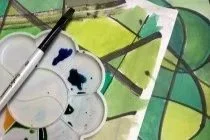Subtractively mixing transparent media
WORKING WITH COLOURS:
Exploring Mixing Processes
Explore the subtractive mixing process using filters and watercolour paints
Details:
Middle-high school and up
Time: 20 minutes
Learning Outcome: Notice and describe the variety of greens produced by mixing various yellows and blues in different transparent media.
Colour Concept: In the subtractive mixing process, the final mixed colour depends on the components and the media used.
Part 1 Materials: Overlapping coloured filters
Light table or Colour Savvy app (Option 1)
White flashlight (Option 2)
Instructions:
Figure 1. Overlapping blue and yellow coloured filters on a light table.
Option 1: Choose the yellow and blue coloured filters from the filter set. Overlap them / place them on top of each other on the Light table, or the Colour Savvy app. What colour do you see?
Option 2: Choose the yellow and blue coloured filters from the filter set. Overlap them, and shine the white flashlight through both filters. What colour do you see?
Part 2 Materials: Liquid watercolours
Liquid watercolour paints: yellow, blue, and magenta
Black India ink with brush, or black marker.
Brushes, plastic palettes, cup of water, paper towels
Instructions:
Figure 2. Filling in a variety of shapes with variations on mixed greens.
Use the black ink or marker to draw shapes on the heavy paper.
Mix the yellow and blue-coloured watercolours together on the palette and make a variety of vivid and pale greens. Paint approximately half of the shapes on your paper with these various greens.
Mix small amounts of magenta-coloured paint with these greens. In this way you will create a variety of muted and dark greens.
Paint the remaining shapes on your paper with the muted and dark greens.
In some of the coloured shapes, you can paint the same colour over top; in other areas you can paint a different colour over top. This will give you even more variations of greens.
Vocabulary:
Questions & observations:
Are the mixed colours as you expected?
Try using a cyan coloured filter instead of the blue in Part 1. How does the appearance of the greens change?
What’s going on?
In this exercise, subtractive mixing using transparent media occurs with single light beams passing through stacked coloured filters, and with mixed transparent watercolour paints.
In the case of subtractive mixing using light beams passing through stacked coloured filters, the spectral characteristics of the filters determine which wavelengths are absorbed (or subtracted) from the light beam. This determines the perceived colour of the transmitted light.
In the case of the subtractive mixing process using transparent watercolour paints, their transparency allows light to reflect off the white paper underneath the paints, back into our eyes. Therefore, transparent watercolour paints appear to sit on top of the paper which allows light to pass through them according to a mechanism similar to the stacked transparent colour filters example.
Subtractively mixed colorants (or filters) remove light, each with a different range of wavelengths from the same light beam. The remaining light is transmitted to our eyes, and our visual system interprets the light as the mixed colour.
Find out more:
See glossary discussion on the subtractive mixing process and a thorough discussion in comparative mixing.





